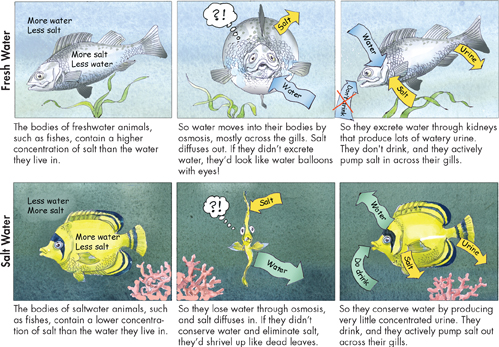VISUAL ANALOGY
EXCRETION IN AQUATIC ANIMALS

FIGURE 27–15 All animals must rid their bodies of ammonia while maintaining appropriate water balance. Freshwater and saltwater animals face very different challenges in this respect. Interpret Visuals What are two ways freshwater fishes avoid looking like “water balloons with eyes”?
dFreshwater Animals Many freshwater invertebrates lose ammonia to their environment by simple diffusion across their skin. Many freshwater fishes and amphibians eliminate ammonia by diffusion across the same gill membranes they use for respiration.
The situation is more complex for some freshwater invertebrates and most freshwater fishes. The concentration of water in their freshwater environments is higher than the concentration of water in their body fluids. So water moves passively into their bodies by osmosis, and salt leaves by diffusion. To help maintain water balance, flatworms have specialized cells called flame cells that remove excess water from body fluids. That water travels through excretory tubules and leaves through pores in the skin. Amphibians and freshwater fishes typically excrete excess water in very dilute urine. Freshwater fishes also pump salt actively inward across their gills.
Saltwater Animals Marine invertebrates and vertebrates typically release ammonia by diffusion across their body surfaces or gill membranes. Many marine invertebrates have body fluids with water concentrations similar to that of the seawater around them. For that reason, these animals have less of a problem with water balance than do freshwater invertebrates. Marine fishes, however, tend to lose water to their surroundings because their bodies are less salty than the water they live in. These animals actively excrete salt across their gills. Their kidneys also produce small quantities of very concentrated urine to conserve water.

Table of Contents
- Formulas and Equations
- Applying Formulas and Equations
- Mean, Median, and Mode
- Estimation
- Using Measurements in Calculations
- Effects of Measurement Errors
- Accuracy
- Precision
- Comparing Accuracy and Precision
- Significant Figures
- Calculating With Significant Figures
- Scientific Notation
- Calculating With Scientific Notation
- Dimensional Analysis
- Applying Dimensional Analysis




